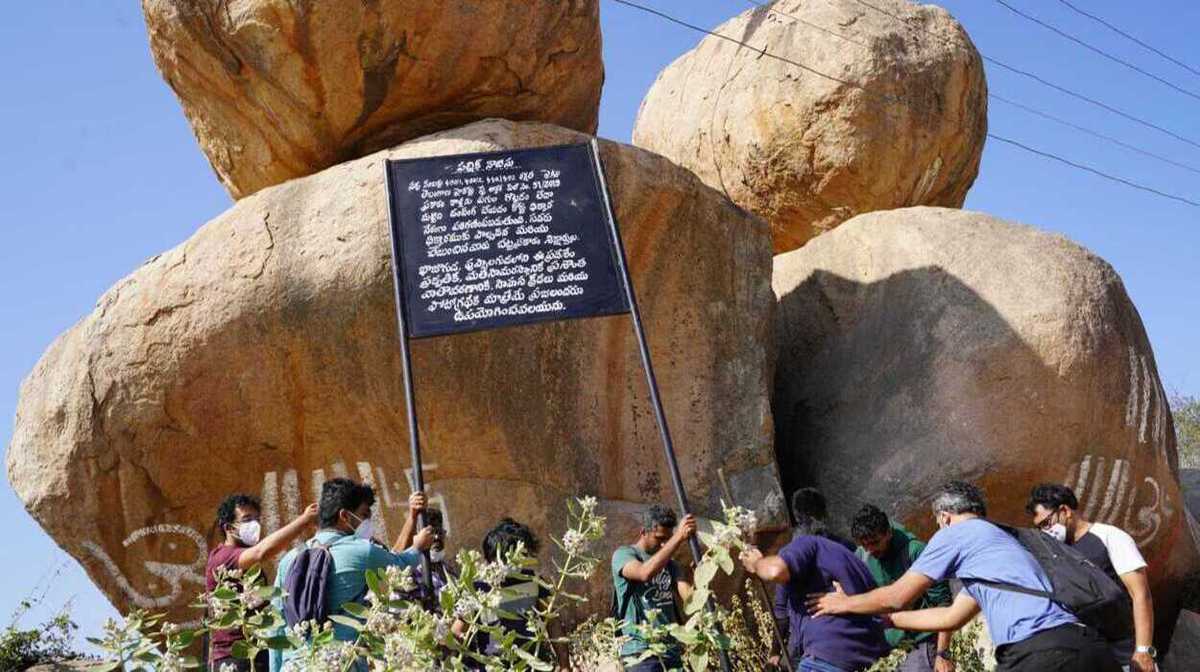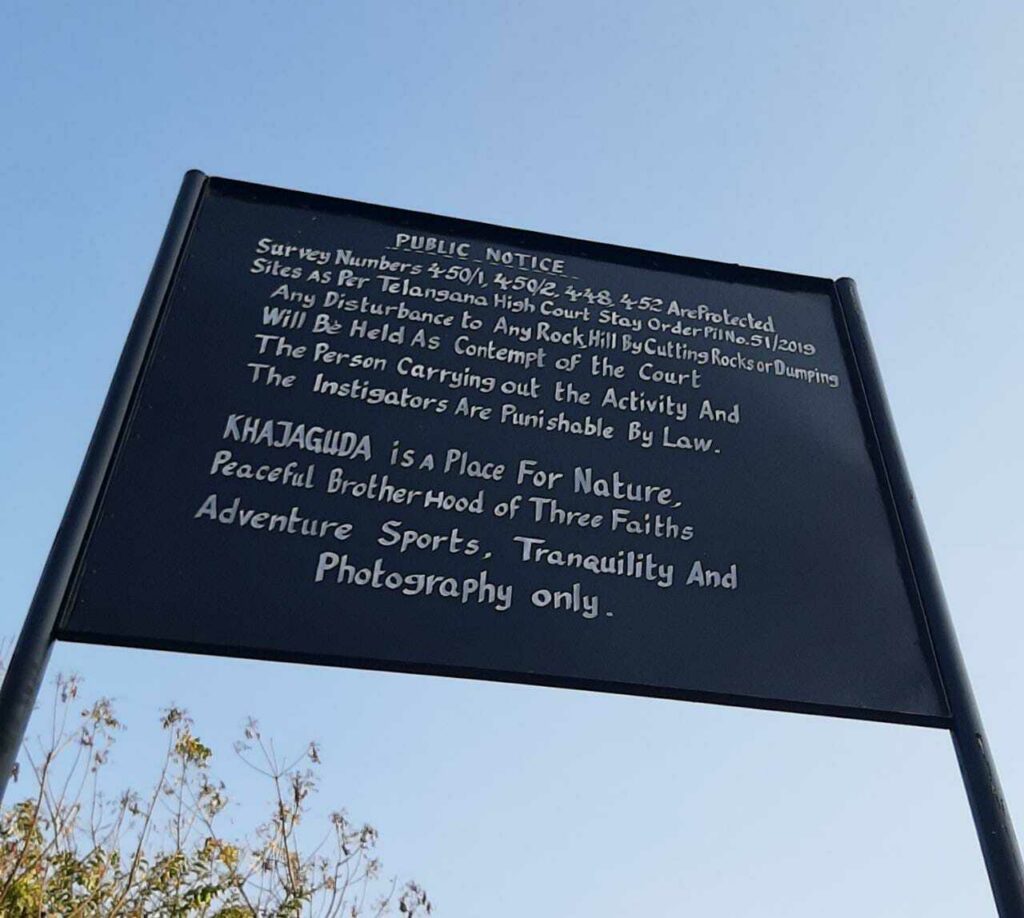
Hyderabad: Activists have set up display boards in English and Telugu at the heritage site of Khajaguda Hills on Sunday citing the order of the Telangana High Court from 2019. They will also soon be filing a contempt of court against the Hyderabad Metropolitan Development Authority (HMDA) and the Greater Hyderabad Municipal Corporation (GHMC).
Activists and citizen groups organized a protest early on Sunday morning and spoke about the challenges against the conservation efforts and also about the efforts required to bring a permanent solution to the matter.

“Survey Numbers 450/1, 450/2, 448, 452, are protected sites as per Telangana High Court stay order PIL No.51/2019. Any disturbance to any rock, hill by cutting rocks or dumping will be held as contempt of the court. The Person carrying out the activity and the instigators are punishable by law. Khajaguda is a place for nature, peaceful brotherhood of three faiths, adventure sports, tranquillity, and photography only,” the boards read.

When the activists were in the process of placing the boards at locations that were prone to destruction in the past, the temple authorities questioned them. Heated conversations followed for close to an hour. Arun from the Save Khajaguda group explained the High Court order to them and everybody, in the end, agreed that the rocks should be protected and the temple authorities also took part in the protest.


Anant Mariganti, who heads the Hyderabad Urban Lab, an organization that conducts urban research and community engagement activities, addressed the protest and explained the ecological significance of the rocks.
“The Temple, The Dargah, The Rock Climbers, The Walkers, and the conservationists should all come together because it holds extreme importance to all of us. We have already lost quite a number of such hills due to real estate and ‘development’ activities. If a rock moves, a bird loses its nest, honeybees lose their habitat. The water moves away and the plants die. You cannot cut down a wild parijatham plant (jasmine) in the forest and then nurse a rose plant in its place,” he said.

A local from the Puppalguda Village who has been visiting the site from her childhood said that the site is very important to locals of the village. “Khajaguda Rock formation (Fakruddin Gutta/Anantha Swamy Gutta) is actually surrounded by three villages – Puppalguda, Manikonda, and Khajaguda. Puppalguda locals used to go to the temple or Dargah by the steps which were built by our ancestors using small rocks. Unfortunately, those steps on the Puppalguda side (tongue rock side) were destroyed a few years ago and there was only one road on the other side of the hill i.e., from Khajaguda (and now some people think that a road from the Puppalguda side should also be constructed). People started calling it Khajaguda because it’s easy to give directions and also because the road starts from that village,” she said speaking to siasat.com.

What are Khajaguda Rocks?
Fakhruddin Gutta, popularly known as Khajaguda Hills, is a protected heritage site immensely loved and visited by trekkers, rock climbers, walkers, and others. However, for more than a decade, the place has been witnessing drilling and destruction for the purpose of ‘development’, which is now being met with resistance from activists and various citizen groups.



The site with rocks dating to several million years is located in Nanakramguda and is just a 20-minute drive from the Amazon Hyderabad campus and the Indian School of Business (ISB) in Gachibowli. It provides a green lung space amidst the hectic, concrete-filled IT corridor. It is also the location of the Hyderabad Climbing Championship that is gaining recognition across the country.
The rock formations at Khajaguda, dating to several million years, are unique in several ways. Several caves systems in Telangana are not formed by the movement of water, but by the gradual weathering and breaking away of granite in hillocks. The largest of these open cave formations in the region are found at Khajaguda. Besides the unique open cave system, there are also projections at Khajaguda that are important for their geological and aesthetic value. The geological term for these projections is Castle Koppies, Kopje, or Tors, better known locally as the ‘sandwich rock.’ These, too, are the largest of their kind to be found in the region, cannot be found anywhere else.
The forest patch at Khajaguda is home to several species of plants, that just like the rock formations, are difficult to find near Hyderabad. The Nyctanthes arbor-tristis, popularly known as the parijata or the night-flowering jasmine, is found in abundance at Khajaguda (there are three national parks around Hyderabad and the Parijata cannot be found in any of these three parks). The other important plant species at Khajaguda is the Helicteres isora, also known as the Indian Screw Tree. These trees have not been recorded by the Botanical Survey of India in any areas around Hyderabad. Khajaguda is the only place where these can be found.
Several species of these plants and trees have been lost in Khajaguda over the last few years. In 2020, over 100 trees, which include Neem, Indian Laburnum, Sitaphal, and many more. In January 2022 alone, 80 trees were lost as the soil was dumped in different places and trees were felled under the guise of a plantation drive.
In Hyderabad, the movement of water is additive: water moving through different places adds up and moves in large quantities until it reaches a lake. The disruption of drainage systems in Hyderabad that had been formed over several years, has recently led to repeated instances of flooding and property damage. Now, with the water channels at Khajaguda disturbed, it is likely that the water will now find its way into the surrounding low-lying areas and flood both urban and rural settlements. (Source: Save Khajaguda, A Citizens’ Report on the Need to Protect Hyderabad’s Ecological Heritage)
An online petition put out by ‘Society to Save rocks’ is trending online and is appealing to the various departments of the Government of Telangana to ‘Save Rocks of Khajaguda /Fakhruddingutta, Hyderabad, Telangana and also has the following demands:
1) To immediately stop the destruction of rocks at Fakhruddingutta
2) To include all the heritage rock formations listed as per previous G.O’S in the Telangana Heritage (Protection, Preservation, Conservation, and Maintenance) Act, 2017.
3) Develop Fakhruddingutta into a Rock, Nature, and Adventure Park for the citizens of Hyderabad.



